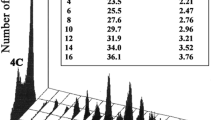Abstract
Although the mechanisms leading to gene amplification are poorly understood, it has recently been proposed that the initial event of amplification is the rereplication of a variable, but relatively large, amount of the genome within a single cell cycle. We sought evidence for rereplication of DNA as a basis for gene amplification through two cytogenetic techniques: differential staining for sister-chromatid exchange analysis and premature chromosome condensation. Synchronized Chinese hamster ovary cells were incubated continuously with bromodeoxyuridine and treated with hydroxyurea (HU) when cells were approximately 2 h into the S phase. After 6 h exposure to HU, the drug was removed and at 3 h intervals thereafter metaphase cells were collected and the chromosomes were stained by the fluorescence-plus-Giemsa procedure. No staining patterns consistent with rereplication of DNA were observed. Since HU causes cytogenetic damage, the premature chromosome condensation technique was used to determine the kinetics of chromosome damage after removal of HU. Extensive G2 chromosome damage within 1 h after removal of HU from the medium was found, although cesium chloride gradient analysis showed that there was no rereplication of DNA during this time. Contrary to a previous report, these results provide no evidence that incubation of cells with HU during S phase induces rereplication of DNA within a single cell cycle. The results observed are consistent with the hypothesis that drug-induced aberrations and the subsequent abnormal segregation of chromosomal fragments are the first steps in the process that leads to gene amplification in drug-treated mammalian cells.
Similar content being viewed by others
References
Alt FW, Kellems RE, Bertino JR, Schimke RT (1978) Selective multiplication of dihydrofolate reductase genes in methotrexate-resistant variants of cultured murine cells. J Biol Chem 253:1357–1370
Botcham M, Topp W, Sambrook J (1978) Studies on Simian virus 40 excision from cellular chromosomes. Cold Spring Harbor Symp Quant Biol 43:709–719
Brown PC, Tlsty TD, Schimke RT (1983) Enhancement of methotrexate resistance and dihydrofolate reductase gene amplification by treatment of mouse 3T6 cells with hydroxyurea. Mol Cell Biol 3:1097–1107
Hahn P, Kapp LN, Morgan WF, Painter RB (1986) Chromosomal changes without DNA overproduction in hydroxyurea-treated mammalian cells. Cancer Res (submitted)
Johnson RT, Collins ARS, Waldren CA (1982) Prematurely condensed chromosomes and the analysis of DNA and chromosome lesions. In: Rao PN, Johnson RT, Sperling K (eds) Premature chromosome condensation. Academic Press, New York, pp 253–308
Kaufman RJ, Sharp PA, Latt SA (1983) Evolution of chromosomal regions containing transfected and amplified dihydrofolate reductase sequences. Mol Cell Biol 699–711
Latt SA (1973) Microfluorometric detection of deoxyribonucleic acid replication in human metaphase chromosomes. Proc Natl Acad Sci USA 70:3395–3399
Mariani BD, Schimke RT (1984) Gene amplification in a single cell cycle in Chinese hamster ovary cells. J Biol Chem 259:1901–1910
Morgan WF, Wolff S (1984) Induction of sister chromatid exchange by 3-aminobenzamide is independent of bromodeoxyuridine. Cytogenet Cell Genet 38:34–38
Pantelias GE, Maillie HD (1983) A simple method for premature chromosome condensation induction in primary human and rodent cells using polyethylene glycol. Somatic Cell Genet 9:533–547
Perry P, Wolff S (1974) New Giemsa method for the differential staining of sister chromatids. Nature 251:156–158
Timson J (1975) Hydroxyurea. Mutat Res 32:115–132
Author information
Authors and Affiliations
Rights and permissions
About this article
Cite this article
Morgan, W.F., Bodycote, J., Fero, M.L. et al. A cytogenetic investigation of DNA rereplication after hydroxyurea treatment: implications for gene amplification. Chromosoma 93, 191–196 (1986). https://doi.org/10.1007/BF00292737
Received:
Issue Date:
DOI: https://doi.org/10.1007/BF00292737




